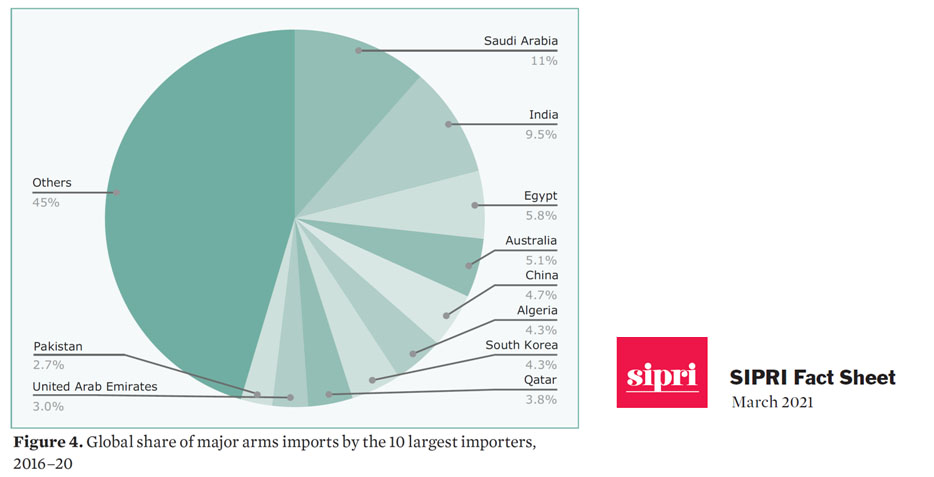Excellent study material for all civil services aspirants - begin learning - Kar ke dikhayenge!
DEFENCE SECTOR IN INDIA – EVOLVING DYNAMICS
Read more on - Polity | Economy | Schemes | S&T | Environment
- Size and funding: India is among the top 5 countries spending on defence. India has the second largest standing army in the world. As per the FY 2018-19, the allocation for defence in India's budget was US$ 45.61 bn (excluding defence pension). Around one-third of this amount is allocated for capital expenditure. Foreign vendors provide for more than 50% of defence equipment procured. This offers a huge opportunity for import substitution.
- Defence imports: India’s requirements on defence are catered largely by imports. The opening of the Defence sector for private sector participation will help foreign Original Equipment Manufacturers (OEMs) to enter into strategic partnerships with Indian companies. This will enable them to leverage the domestic markets as well as aim at global markets. Besides helping in building domestic capabilities, it will also bolster exports in the long term.
- Offset policy: The offset policy stipulates the mandatory offset requirement of a minimum of 30% for procurement of defence equipment with foreign defence players. It is applicable on categories of procurements where the estimated cost of the acquisition proposal is US$ 286.04 mn or more.6 It would also ensure that an eco-system of suppliers is built domestically.
- Favourable policies: Favourable government policy which promotes self-reliance, indigenisation, and technology upgradation. The policies also aim at achieving economies of scale, including the development of capabilities, for exports in the defence sector. India’s extensive modernisation plans with an increased focus on homeland security and growing attractiveness as a defence sourcing hub.
- Huge imports and opportunity for substitution: India was the second largest importer of arms during 2014-18 with a share of 9.5% of the total world imports. Around one-third of the allocation to defence (excluding defence pensions) in the budget is allocated for capital expenditure. Capital allocation for the Ministry of Defence is 32.19% of the total Central Government capital expenditure in 2019-20 Budget Estimate. More than 50% of defence equipment procured between March 2014 and November 2017, were signed with foreign vendors. This offers a huge opportunity for import substitution.
- DPP: The Defence Production Policy, 2011 encouraged indigenous manufacturing of defence equipment. Draft Defence Production Policy was introduced 2018. The Defence Procurement Procedure (DPP), 2011 was amended in 2016 to provide for institutionalising, streamlining and simplifying defence procurement procedure to give a boost to “Make in India”.
- Buy Indian IDDM: A new category of capital procurement was created – Buy Indian - Indigenously Designed, Developed and Manufactured (IDDM) to encourage indigenous design, development and manufacturing of defence equipment.
- Preference: MOD gives preference to (a) ‘Buy (Indian- IDDM)’, (b) ‘Buy (Indian)’ and (c) ‘Buy and Make (Indian)’ over (d) ‘Buy (Global)’ category for capital acquisition.
- Simplified MAKE-II: It was launched in January 2018, for simplification of collaboration between government and private Indian industries for indigenous design, development and manufacture of defence equipment.
- FDI policy: Up to 49% is available under automatic route and above 49% through Government route, where it is likely to result in access to modern technology. The Defence industry is subject to industrial licenses under the Industries (Development and Regulation) Act, 1951 and manufacturing of small arms ammunition under Arms Act, 1959. The requirement of a single largest Indian ownership of 51% of equity removed. A lock-in period of 3 years on equity transfer has been done away with in FDI for Defence.
- Procurement policy: Defence procurement is governed by the Defence Procurement Procedure (DPP 2016). It focuses on institutionalising, streamlining and simplifying defence procurement procedure.
- Defence Offset Policy: The key objective is to leverage capital acquisitions to develop the domestic Defence industry. The policy stipulates the mandatory offset requirement of a minimum of 30% for procurement of defence equipment by foreign defence players. It is applicable on categories of procurements where estimated cost of the acquisition proposal is US$ 286.04 mn or more.
- Latest Budget provisions: Development of two defence-related industrial production corridors + Announcement of an industry-friendly Defence Production Policy 2018 to promote domestic production by the public sector, private sector and MSMEs + Defence Budget reached US$45.61 bn in 2019-2025
- Foreign investors: These have arrived in India till date – Airbus (France), BAE India Systems (UK), Pilatus (Switzerland), Lockheed Martin (USA), Boeing India (USA), Raytheon (USA), Israel Aerospace Industries (Israel), Rafael Advanced Defense Systems Ltd. (Israel), Dassault Aviation SA (France)
- Agencies involved: Department of Defence Production (DDP), Ministry of Defence; Department for Promotion of Industry & Internal Trade (DPIIT), Ministry of Commerce & Industry; Department of Commerce (DOC), Ministry of Commerce & Industry; Defence and Strategic Industries Association of India
* Content sourced from free internet sources (publications, PIB site, international sites, etc.). Take your own subscriptions. Copyrights acknowledged.



















COMMENTS